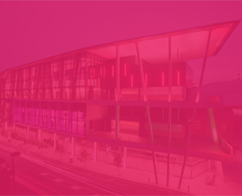
Gold Coast
April 11-12, 2026
Gold Coast Convention & Exhibition Centre



The release of Australian psychological thriller Reaching Distance is fast approaching, but before screenings around the country commence, we caught up with director David Fairhurst for an exclusive insight into the creative process.
Fairhurst’s debut film was made “entirely outside of the established industry”, shot in a warehouse in Sydney and “breaking every rule” of how things are meant to be done.
The film follows Logan (Wade Briggs), a man with a photographic memory who follows his sister’s killer onto a NightRider bus, and that’s when the lines between reality and memory fracture and things take a bizarre and intense turn.
Here’s a behind-the-scenes look at how the team constructed the bus for filming and some further insight from Fairhurst.
Where did the inspiration for this story come from?
I experience Déjà Vu way more aggressively than most people and I tend to get little paranoid that I have definitely lived or seen a moment in time before. Reaching Distance is based on that “What If?” scenario; what if it really isn’t Déjà Vu and instead something is actually very, very wrong?
What were some of the benefits of your DIY approach?
Using old-school visual effects and doing as much as possible practically gives the film a unique look that you don’t see much of anymore. Particularly the rear-projection setup we created to make the bus look like it was moving added a beautiful mix of colours throughout and kept the single location consistently interesting. We were also able to project abstract and long exposure plates onto the projection screens as the film gets crazier.
Considering we were working with a low budget, it was also far more cost-effective than resorting to VFX. If we had gone with green-screen instead of rear-projection, our post-production budget would have exploded and made the film impossible to achieve with the resources we had. There are only five green-screen shots in the final film.
And the challenges?
Removing every seat from the bus individually by hand was certainly a huge pain. And at times, the DIY approach was unnecessarily time-consuming. You also need to work hard to muster the trust of your crew, because my approach was typically different from industry standards and some ideas looked weird or straight up stupid on set. Thankfully, they did and everything worked out great in the edit.
Given it was your debut feature, what were some of the main things you learnt along the way?
Definitely how aggressively collaborative a film set needs to be to work successfully. While you do need to have an overall vision, most of your role as a director requires listening to your cast and crew on their ideas on the best way to achieve that. So being willing to listen to every idea is a must but that also comes with saying “no” a lot, which can be difficult.
It was also eye-opening, just how long it takes to get a feature made outside of the established industry. The script was written four years ago and is only getting released this week.
How close did the final product come to your initial vision?
The visual side of the film is extremely close to what I envisioned, the biggest changes from script to screen were actually tonal. The original script would weave back and forth between lighter and darker moments quite abruptly but a few cast members found those shifts clashed with their methods. So a few of my favourite jokes were excised along the way but we were left with a far more tonally consistent film. And one that has been easier to market now that it clearly falls into a psychological drama/thriller category.
————————–
Reaching Distance is scheduled to screen in Adelaide, Brisbane, Sydney, Melbourne and Perth over the next month, with all the details available via the film’s website.






